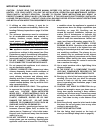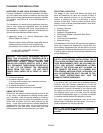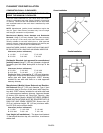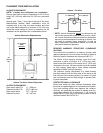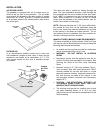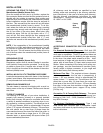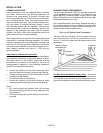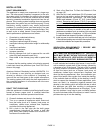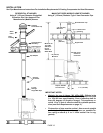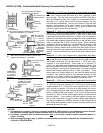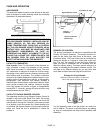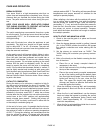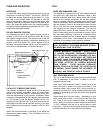
INSTALLATION
PAGE 10
CHIMNEY INSPECTION
Existing chimneys must be inspected before installing
your stove. Consult your local building department for
chimney code requirements. A masonry chimney must
have a code approved liner. This liner must not have bro-
ken or missing pieces. Some non-code masonry chim-
neys may be brought up to code by being relined. (Con-
sult your dealer or qualified chimney sweep). Factory
built chimneys should also be inspected, first for creo-
sote deposits (which should be removed), and then for
integrity of the stainless steel liner. Look for obvious
bulges in the lining, which may indicate the need to re-
place that section (use a bright flashlight).
Also, inspect the attic to see that the chimney has proper
clearance to combustible framing members. For interior
masonry chimneys and most factory-built chimneys, this
must be a 2“ (51 mm) air space clearance, which must
not be filled with insulation or any other material. An ex-
terior masonry chimney must have a 1“ (25.4 mm) air
space clearance.
Vapor Barrier At Chimney Penetration
Install all venting components per the Vent Manufactur-
ers installation instructions. Ensure that there is an effec-
tive vapor barrier at the location where the chimney
penetrates to the exterior of the structure. This can be
accomplished by applying a non-hardening waterproof
sealant to the following components:
• Around the chimney at the point where the storm
collar will meet the chimney just above the Flashing.
• Along the vertical seam of the chimney pipe, where it
is exposed to the weather.
• On each nail head on the flashing.
• Around the chimney at the point where the storm
collar will meet the chimney just above the flashing.
Notes:
• On a flat or tarred and graveled roof, nail and seal
the flat roof flashing to the roof on all sides with roof-
ing compound.
• Do not put screws through the flashing into the chim-
ney pipe.
CHIMNEY HEIGHT REQUIREMENTS
The chimney must extend 3 feet (914 mm) above the level
of roof penetration and a minimum of 2 feet (610 mm)
higher than any roof surface within 10 feet (305 cm) (see
below). Check with your local building officials for any addi-
tional requirements for your area.
Due to prevailing winds, local terrain, adjacent tall trees, a
hill, or ravine near the home, or adjacent structures, addi-
tional chimney height or a special chimney cap may be re-
quired to ensure optimum performance.
The 2’ by 10’ Rule for Vent Termination
The top of the flue must be 2’ (610 mm) higher than any
part of the roof within 10’ (305 cm) horizontal and a mini-
mum of 3’ (915 mm) higher than the highest point of roof
penetration.
For Manufactured (Mobile) Homes Only
: Portions of
the chimney and termination that exceed an elevation of
13½ feet above ground level may be designed to be re-
moved for transporting the manufactured (mobile) home.
Requires A Listed
Termination Cap
2’ (610mm)
10’ (305 cm)
3’ (915mm)



